 |
| Fig. 1 |
Franz Kröger
Offering Bowls
In addition to other unrealistic means of artistic expression, it is the concave skulls of Komaland terracottas in particular that strike the observer as an
extraordinary way of representing a human head. Representations like these can only very rarely be found among any other West African figurative sculptures.
 |
| Fig. 1 |
That the bowl-like concavities were probably of
greater functional importance than the faces of the figurines themselves is proven by some
figures with large bowls but missing or stunted faces as they appear in the faceless cones
described below (cf. Fig. 6).
In the centre of the bowl-like skulls, there is usually a small strip of clay, which Detavernier
(1990) calls “languette” and Broggini (1992) “linguetta”. Generally, it is accompanied by a
slit-shaped incision or a deep hole.
Some of these structures resemble cowries (Fig. 1) so that Anquandah interprets them as “hats with cowries in the top centre” (1985: 31).
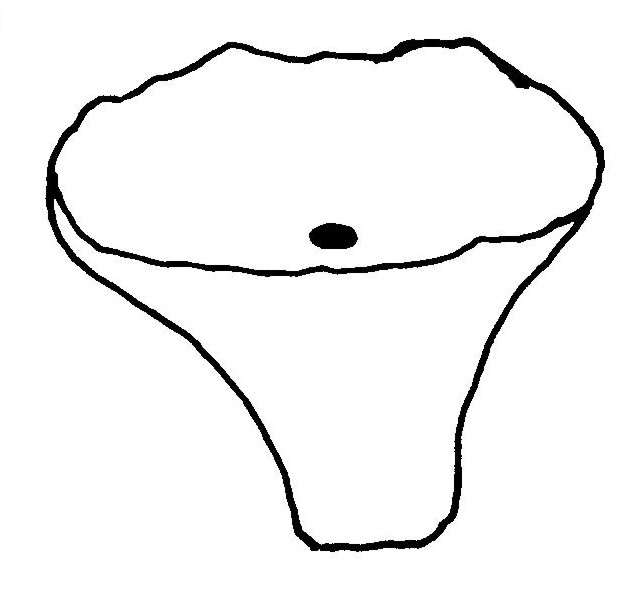 |
|
Fig. 2 |
Also Dagan (1989: 21) and Detavernier (1990: 20) refer to them as cowries, regarding them as female sexual symbols.Other forms which should probably have the same function do, however, not resemble a cowrie in any way. In some of the head bowls, there is only a deep, round hole without a clay strip (Fig. 2), while in others (Fig. 3) there is a strip of clay without a hole. It is, however, possible that the strip broke off and the hole got blocked up completely. In two adjacent bowls, the strip usually extends from the middle of one bowl and over its edge to the next bowl (Fig. 4).
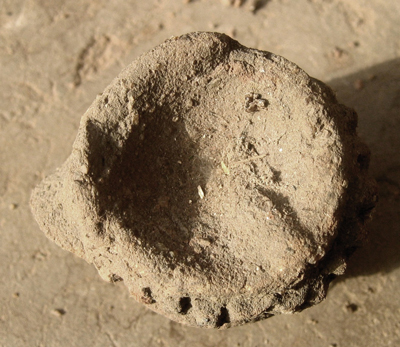 |
|
Fig. 3 |
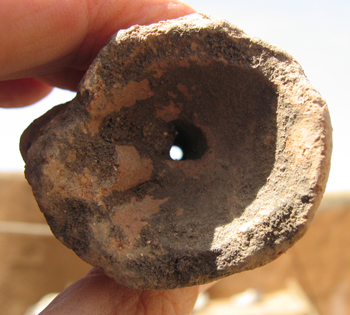 |
|
Fig. 5 |
The pierced holes often have a considerable depth of several centimetres (up to 4.5 cm according to Dagan), and these holes sometimes reach up to the middle of the figure. If a head breaks off from the body, the hole sometimes allows one to look through the entire head (Fig. 5). The depth of the skull hole corresponds to those in the ear and nose holes. In a conical figure, Dagan (1989: 15) discovered a connection between the hole in the skull concavity
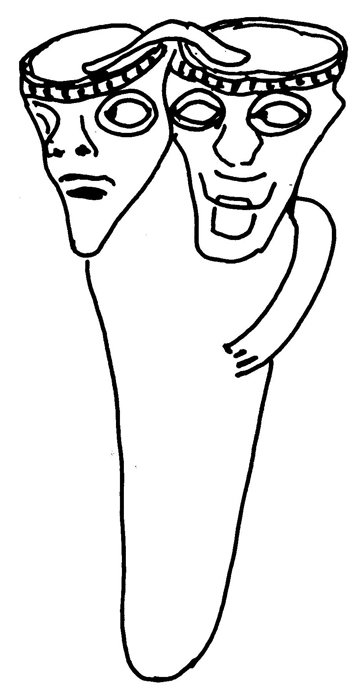 |
|
Fig. 4 |
and the deep hole of the left ear by pouring a liquid into the skull hole. This liquid flowed out of the left ear. A connection to the nostrils is suspected, too. After experimental verifications by other owners of Komaland terracottas, Dagan’s observed phenomenon, however, could not be confirmed by further evidence. It may therefore be a coincidence that the deep head hole crossed an ear hole inside the figure.
On the other hand, the application of "channels" within a figure is not unique within West
Africa, as cross-sectional drawings of Kabye figures (Verdier 1981: 111-112) demonstrate.
Here the hole in the skull leads far into the interior, and branches approximately in the centre
of the figure into two channels that lead down to the base. The head cavity (cavité de la tête)
receives milk (as a sacrifice?). According to Hersak (2010, Fig. 42-44, 7-8) wooden Songye
figures are equipped with a real interior channel system which connects the mouth, the head,
the cavity in the belly and the anus.
Any interpretation of the bowls with holes or slits has to take into consideration that the same
phenomena occur in other parts of anthropomorphic and zoomorphic Komaland figures.
What is striking is the presence of the clay strip together with a slit or hole in the wide-open
mouths of those figurines that have no concave head shape. Of course, in the mouth, the flat
clay particle can easily be interpreted as a tongue, and a simple deep hole in the deeper parts
of the mouth can be interpreted as the throat.
The open mouth has become the subject of very Euro-centric interpretations, when, for example, such figurines are called "screaming persons". Such an interpretation doesn’t match with the general appearance of the other Komaland sculptures, which represent people in a reposing, dignified position. Furthermore, representations of utterances do not fit in the general Komaland cultural context. Also, associating the open mouths with “people singing in a chorus” probably does not correspond with the intended purpose of the creators (and, furthermore, should animals with open mouths also carry out this activity?).
It should also be explained why, with some figures, the sacrificial cavities occur in the skull or on top of a faceless cone while others have open mouths for receiving sacrifices. Among other reasons, practical considerations may have played a role. With the relatively small coned figures stuck firmly into the ground, it would have been difficult to fill their open mouths with sacrificial food. Figures with a flat base (as they appear with most Janus figures) might be taken in the hand and supplied with the appropriate quantity of food in the mouth. A nearly ideal solution has been found in the head shape of certain Janus figures. In these, the head consists of a flat, horizontally positioned elliptical disk with the two open mouths facing upward, thus allowing a libation to be poured on the figure from above.
If the figures represented, as is commonly believed, supernatural, venerable beings (ancestors, bush spirits, etc.), they also received sacrifices. It is assumed that all of the skull bowls and the wide open mouths with deep throats had the same purpose: namely, to receive and convey the libations into the interior of the figure (Kröger 1988, 134-35).
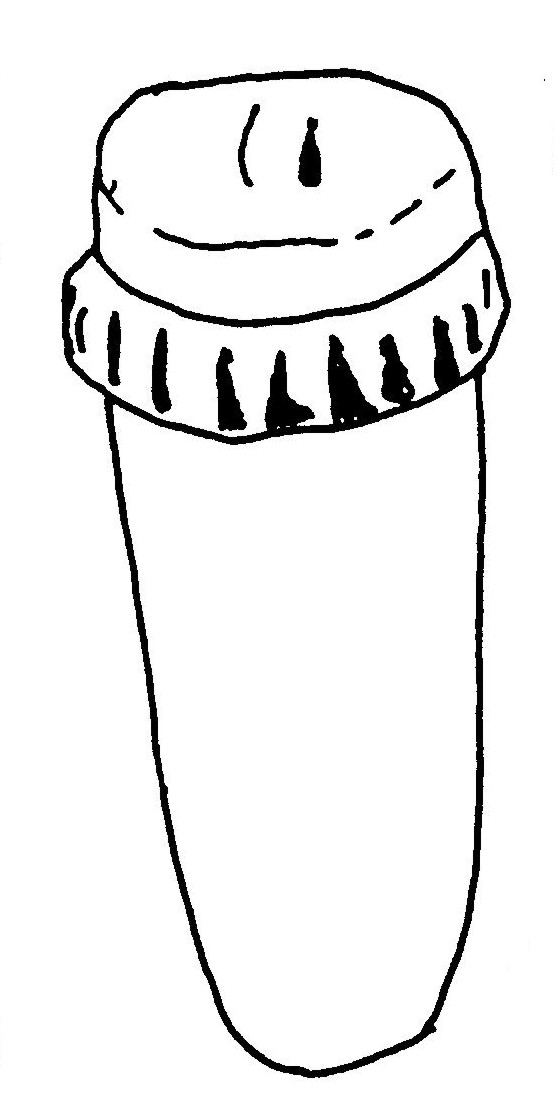 |
|
Fig. 6 |
Cone-shaped clay objects without anthropomorphic characteristics have so far resisted all attempts at interpretation (Fig. 6). In catalogues they often appear as "unidentified objects".
Even if they are interpreted here as sacrificial bowls with a coned peg below, important questions remain unanswered, such as whether they constituted an independent shrine or whether they were just accessories of other figures. I am inclined to accept the first assumption, for all the other anthropomorphic figures have sacrificial bowls of their own. Moreover, the cones were probably conceived as greatly simplified anthropomorphic representations because the transition from a conically or cylindrically shaped figure to one with many human traits can be demonstrated through numerous intermediate forms (Fig. 7). The illustrated examples, possibly from different eras, should of course not be considered to demonstrate a unilineal evolutionary series but only potential steps between the non-anthropomorphic and anthropomorphic objects.
 |
| Fig. 7 |
Also, the meaning of two coned objects placed in front of a female figure give
rise to speculations (Fig. 8-9). In oral interviews, experts on the Komaland
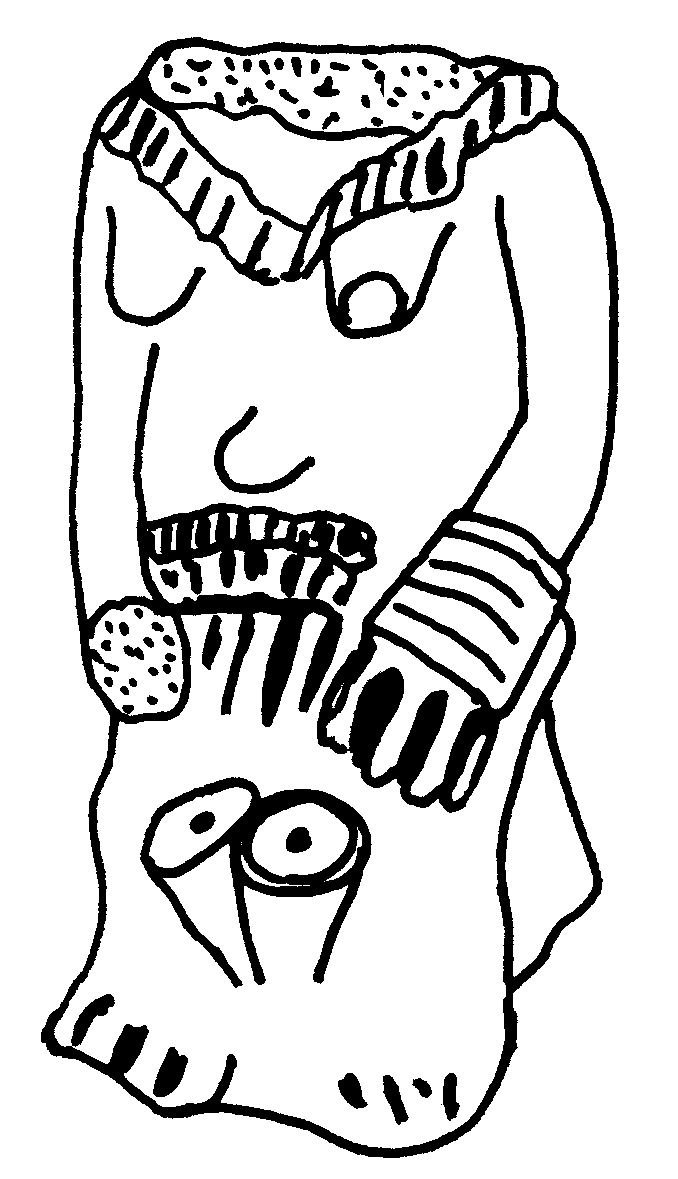 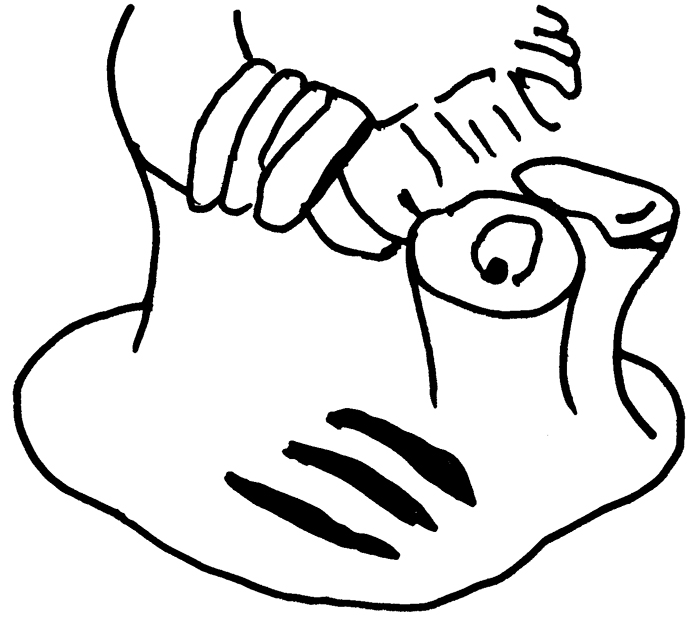 |
|
Fig. 8 - 9 |
terracottas assumed several times that drums are depicted here. There is indeed a certain resemblance to cylindrical or hourglass-drums. The latter, however, are never played standing on the ground in front of a player. Moreover, it is remarkable that the terracotta “drums” are always placed here in front of female characters. In West Africa, drummers are usually male, though in ritually exceptional circumstances, drums are also played by women. Anquandah (1998: 94, Fig 6.13) suggests that such representations are women before their grinding bowls, although in his pictures, clay strips with holes are clearly visible at the bottom of the bowls.
A plausible explanation for the strips, slits and holes in the cavities is difficult to establish. If the libation was originally offered in the mouth, it is quite possible that the tongue and throat really were depicted. These formal elements and the idea that the sacrificial food should penetrate into the interior of the body might then have been transferred to the skull bowls.
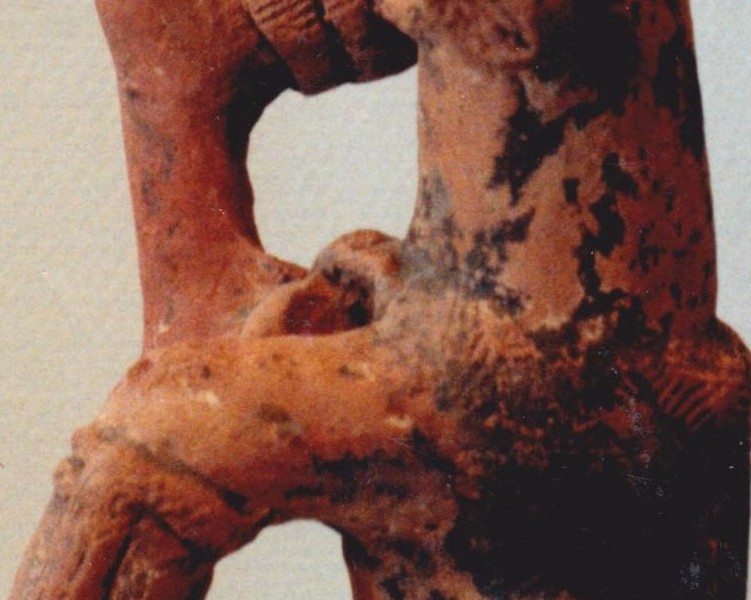 |
|
Fig. 10 |
In addition to the places for sacrifices in the skull, as discussed above, there are possibly other spots on the bodies for receiving sacrifices. A few terracotta figures have no cranial cavities and no open mouths. However, their outstretched hands are moulded into bowl-shapes and were quite capable of holding liquid or solid offerings. Such bowl-shaped palms
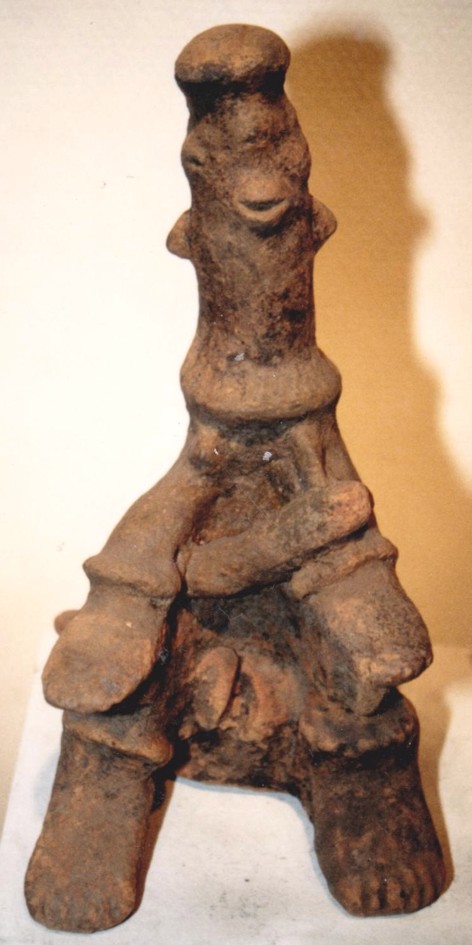 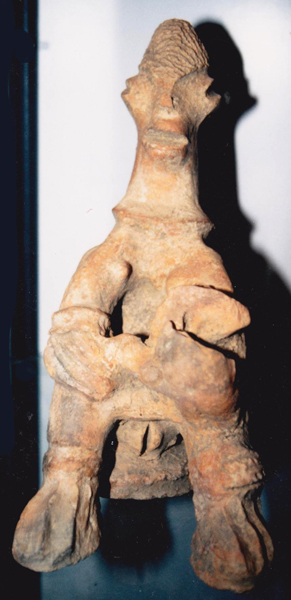 |
|
Fig. 11 - 12 |
are particularly common on anthropomorphic vessels.
The terracotta in Fig. 10 has neither an open mouth nor a cranial cavity nor
outstretched hands. Instead, its transverse, oversized vagina is wide open and
might have been able to receive libations.
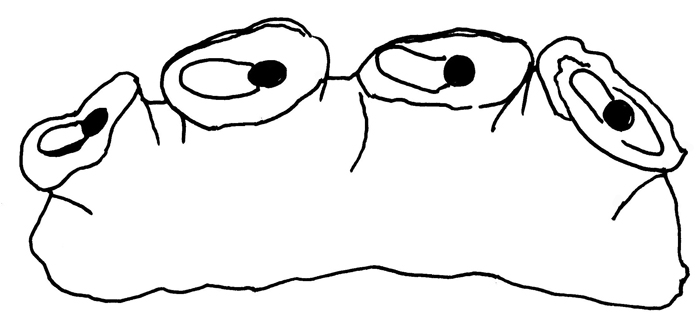 |
|
Fig. 13 |
Also, the open female genitalia of some mother-figures may have had a similar function (Fig. 11-12).
The sacrificial bowl of a figure cannot only be doubled or tripled. Up to 20 bowl-like cavities can be arranged on a ceramic base, either irregularly or in rows. We can, however, only be sure that these cavities are offering bowls when there is the clay strip with a hole or slit, as is the case, for example, in Fig.13.
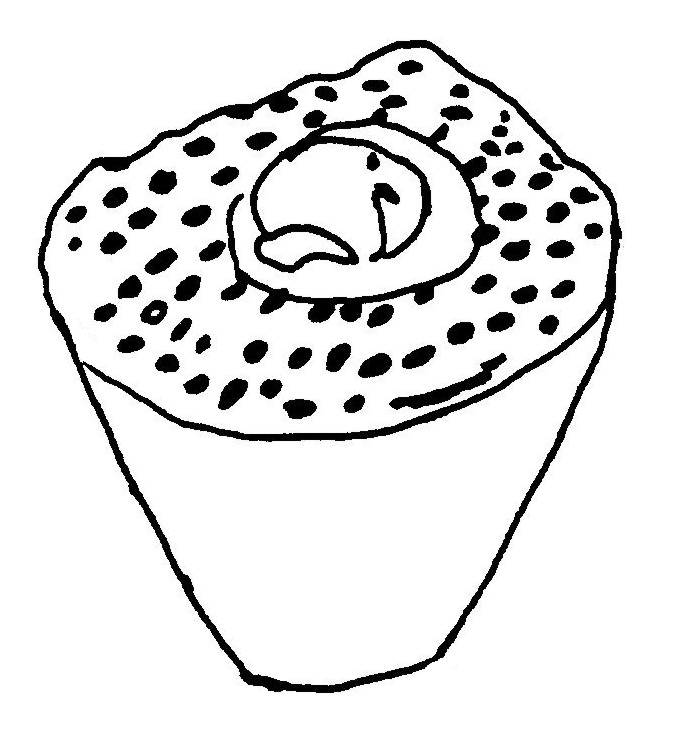 |
|
Fig. 14 |
Those ceramic objects with numerous point-like holes are enigmatic. Although Fig. 14 contains a typical sacrificial bowl with a large hole and clay strips in the centre, it is surrounded by about 80 small holes of unknown function.
The often speculative ideas concerning the function of the cavities or bowls at different locations on the figures as well as the meaning of the deep hole and the strips may perhaps be verified or falsified one day when traces of sacrificial food (e.g. blood or millet-water) are found on or in excavated figures.
References
Anquandah, James and Laurent van Ham 1985
Discovering the Forgotten “Civilization” of Komaland, Northern Ghana. Rotterdam: Ralph Schuurman Productions.
Anquandah, James 1998
Koma Bulsa. Its Art and Archaeology. Rome: Istituto italiano per l'Africa e l'oriente Roma
Broggini, Filippo e Romano 1992
Per un' ulteriore interpretazione delle terracotte del Komaland (nord-Ghana). In: Dall' Archeologia all' Arte tradizionale Africana. pp. 51-63. Milano: Centro Studi Archeologia Africana.
Dagan, E.A. 1989
Spirits without boundaries / Les esprits sans frontière. Twenty-six Single Heads from Komaland, Ghana / Vingt-six statuettes de terre cuite à une tete de Komaland, Ghana. Montreal: Galerie Amrad.
Detavernier, Hervé 1990
Terres cuites Koma du Nord-Ghana. In: Arts d'Afrique noire 74, 17-27.
Hersak, Dunja 2010
Reviewing Power, Process, and Statement. The case of Songye Figures. African Arts, 43,2: 38-51.
Kröger, Franz 1988
“Die Terrakotta-Funde des Koma-Gebietes (Nordghana)”, Paideuma 34: 129–142.
Verdier, Raymond 1982
Le pays Kabiye, cité des dieux, cité des hommes. Paris: Edition Karthala.